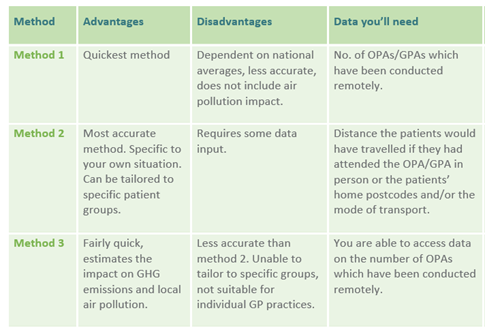
Remote Consultations: Do they reduce Greenhouse Gas Emissions? Your Guide to Calculating the Answer
The Covid-19 pandemic has put an immense burden on the NHS. It required the healthcare system to adapt in order to be able to continue with its services.
Some of the changes had already been set out in the NHS Long Term Plan but have been accelerated during COVID-19 . Offering many health services, from GP to ophthalmic services, remotely is an example. Enabling patients to access remote consultations alongside in-person appointments not only limits the spread of infection, but helps meet the rising demand for healthcare as well as reducing the NHS's carbon footprint, especially from patient travel related GHG emissions which currently contribute 5%.
Remote consultations will never be the only form of appointments. In-person appointments and remote consultations are both essential in delivering healthcare. Work is being done to understand what the most appropriate services are to offer remotely and how the recent switch from in-person appointments to remote consultations has affected patients, staff and quality of care. If the NHS is to fulfil its requirements of the long-term plan and meet its net zero targets, not only do we need to understand how remote consultations affect clinical and patient outcomes, but also how they impact the environment.
To make it easy for health professionals, quality improvement leads, sustainability and practice managers at hospitals and GP practices to measure the environmental impact of switching to remote consultations, the Centre for Sustainable Healthcare has developed a supportive guide. Funded through Q by the Health Foundation and NHS England and NHS Improvement, the guide describes step-by-step three different methods for calculating the greenhouse gas (GHG) emission savings of avoided patient travel and can be used for a specific clinical pathway, a clinical department, or a whole organisation. A new carbon calculator in form of an excel spreadsheet has been developed in collaboration with PD Transformation for method 2.
Which method you decide to use depends on how much time you have, what you would like to use the results for and what data you are able to access or collect. Whether you plan to collect detailed travel data from individual patients or just would like to make a quick estimate, you will be able to choose the method that is right for your analysis. The table below provides a summary of each method. For full instructions, please take a look at the guide.
The guide also includes an outline on how to estimate the carbon footprint of the change in resource use at the GP practice or hospital due to the switch to remote consultations. To look at the guide and use the calculator, please click here.


